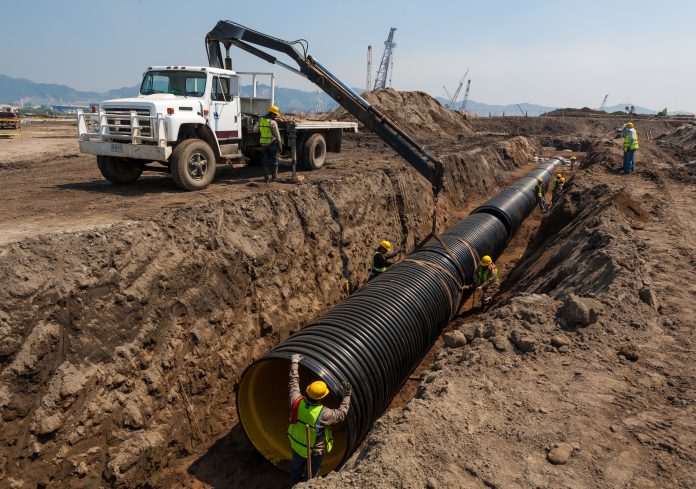Land drainage systems are often supplied in 3 meter double-wall perforated pipes or single-wall flexible coils. And they usually come in numerous pipe sizes as well as coil lengths. Both of these pipes are fully perforated to make it easier for water to flow into the underground drainage pipe. Some water is slowly filtered into the ground while most of it is taken to the final soakaway destination.
Understanding the Basics
Perforated drainage pipe coils typically collect surface water via small holes cut within the dwells of the coil. With a flexible coil structure and a 90-degree bend radius, the pipes offer increased flexibility, efficiency, and reliability. And this can help improve your field’s drainage while also improving its soil quality.
When it comes to construction, drainage pipes play a key role in alleviating floods and relieving the static load on underground structures as well as retaining walls. Even more, perforated land drains are beneficial for sports fields and lawns.
On the contrary, unperforated land drains are designed for distributing surface water since they don’t have any holes for water to flow into. They’re therefore used primarily for attenuation where water is usually stored and then channeled to a watercourse.
Choosing the Right Drainage System
A good land drainage system is a much need solution for those who’ve large land surfaces to irrigate and those who live in areas with higher rainfall rates. People whose land features surface dips, as well as depressions, might also need a reliable land drain design.
If you fall into any of the above-mentioned categories, follow these simple steps to get started.
Establish the Source of Excess Water
Stagnant water causes muddy gardens, flooded yards, as well as soggy lawns. And this often occurs due to excess water and poor drainage. So, before you can start thinking about constructing a drainage system, it’s important that you first try eliminating the excess water by curbing its source. Common sources of such problems include heavy rainfall, broken sprinkler pipes, melting snow, broken underground water pipes, or underground springs.
Fixing broken pipes could permanently eliminate the need to install a drainage system, but if the excess water is coming from unrepairable sources, then you’ll need to consider designing and developing an effective drainage system. And if that’s the case, check out the following aspects:
Soil Composition
Clay soil usually contributes to pooling water. But the good news is that you can always curb this problem by utilizing a garden tiller to thoroughly mix the clay soil with sand, compost, or gypsum.
Land Elevation or Sloping
Your land’s sloping direction will definitely determine the depth of the drainage system you’ll need to direct the water out of your land. Plus, it will also impact the direction in which you’ll need to drain excessive water. What’s more important here is that you ought to design your system in such a way that the site which receives the drained water is lower than the location of pooling water.
Type of Land Drain
When it comes to land drainage products from Easy Merchant, there are three different types to choose from:
Open ditch- For you to create an open ditch, you’ll need to dig at least 12 inches deep and 12 inches wide. If the length isn’t too big and the soil is soft, then you can comfortably dig the ditch by hand. Otherwise, you might need to hire a contractor who has a mechanical ditch digger.
Gravel Trench- Digging an open trench within your yard might not be your idea of aesthetics, and if you prefer an invisible trench, then fill with gravel and cover it up with topsoil or grass. But the only problem with this technique is that it might get clogged by soil that gets washed into it by flowing water.
Drainage Pipe- By utilizing a drainage pipe, you’ll encounter less trouble with clogging, particularly if the pipe diameter is greater than 12 inches. But the greater the pipe size, the higher the cost of materials will be. And if the pipe features multiple sections, the amount of time you need to work will increase since you’ll have to seal each section to prevent dirt from entering the pipe openings.
Typically, most drainage issues can be resolved using one of the above draining methods. Under certain circumstances, you might need to utilize more than one method. Unless the area you’re planning to drain water from is bowl-shaped, you shouldn’t have any trouble keeping your area free of excessive water.
Proper Grading
Your property’s grading also plays a significant role when it comes to draining excess water. Most building codes stipulate that the ground around the building’s foundation should slope away at a minimum of six inches for the first ten feet, and then slope again in the next hundred feet. Remember, this is the minimum requirement- so more slope will definitely help get more water from your foundation faster.
Make sure that you don’t change your lot’s grading, and if you see some low spots developing, be quick to feel them. And if water is constantly accumulating in a specific area, you may want to consider installing a sophisticated French drain. This is a small trench featuring a perforated pipe that’s surrounded by gravel and sand, which directs the excess water away from your foundation without necessarily following the grade. Remember, this won’t only channel the water out of your house, but it will also facilitate the process without any possibility of erosion or water runoff damage. Avail of regular preventive drainage maintenance to save you substantial amounts of money and time. In the long run, this will save you substantial amounts of money and time. Imagine your house or plants being swept away by excess water? That can be frustrating- but thanks to the invention of a sophisticated land drain which has made it possible for people to easily curb this menace.
Conclusion
When it comes to choosing a land drain, there are several things you should take into consideration. Understand the soil composition, determine your land’s elevation, or sloping, know the different types of drain systems, and do proper grading and aluminum guttering. Doing this will help you make an informed decision as far as selecting the best land drain for your building or land is concerned.


































